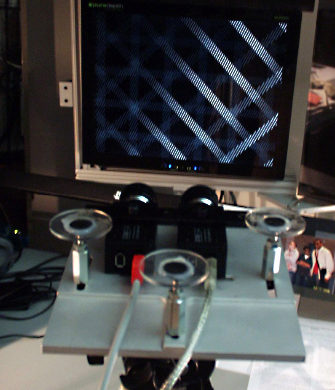Dynallax: Dynamic Parallax Barrier Autostereoscopic Display
April 23rd, 2007
Categories: Devices, MS / PhD Thesis, Software, Visualization, VR

Authors
Peterka, T.About
Tom Peterka’s PH.D. Dissertation - Submitted as partial fulfillment of the requirements for the degree of Doctor of Philosophy in Computer Science in the Graduate College of the University of Illinois at Chicago, 2007.
Parallax barrier strip autostereoscopic (AS) virtual reality (VR) displays have been constructed by placing a barrier of lines in front of an LCD display device. Together with a head tracking system and associated software to interleave portions of left and right eye images in appropriate positions on the display device, an AS effect is achieved that can be quite compelling. In the past, the barrier was a static component that imposes certain imitations on the system. The barrier is manufactured to produce various system parameters such as number of viewers, type of autostereo system, size of working area. For example, in a static barrier head-tracked system the number of viewers is invariably one because of these static barrier limitations.
Substituting a dynamic parallax barrier for the static barrier frees the system from such constraints. Not only can barrier parameters be easily adjusted, but the barrier can be disabled entirely, converting the AS system to a 2D display. View distance range is expanded; moreover optimum optical conditions are maintained throughout the range. The inherent sensitivity to latency in a head-tracked parallax barrier system is mitigated by translating the dynamic barrier image in response to rapid head movements. Finally, by dynamically controlling the parallax barrier in real time, more than two eye channels are produced, for example to accommodate two viewers and provide each viewer with an independent pair of stereo perspectives.
A prototype system called Dynallax is researched and developed to demonstrate the qualities of a dynamic parallax barrier for AS. This is a small single-panel prototype based on a stacked dual-LCD display that is scalable by tiling. Besides investigating Dynallax on a purchased stacked display, improvements in dual stacked LCD construction are investigated by constructing a custom display from dissimilar components. Finally, results are shared with the scientific community through publication in a distinguished virtual reality conference.
Resources
Citation
Peterka, T., Dynallax: Dynamic Parallax Barrier Autostereoscopic Display, EVL, PhD Dissertation, April 23rd, 2007.